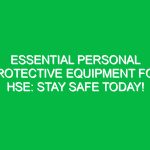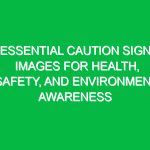Introduction
Hello team! Today, we are here to conduct a crucial toolbox talk on a concept that might just save your life: Leave Yourself an Out. The essence of this principle is simple yet powerful—it is about ensuring that you always have an escape route or a backup plan in any situation you encounter while working. In the Health, Safety, and Environment (HSE) domain, this concept is not just a good idea; it is a necessity. We will explore its importance, practical applications, and how to implement it in our daily routines to promote a safer workplace.
What Does “Leave Yourself an Out” Mean?
At its core, Leave Yourself an Out refers to the practice of ensuring that you always have a safe option available should an unexpected situation arise. This means planning ahead, assessing risks, and being proactive about your Safety. Imagine you’re working at a height, or handling hazardous materials; having a clear escape route or a plan to mitigate potential Hazards is crucial. It’s about maintaining your awareness and being prepared to act decisively when things don’t go as planned.
The Importance of Leaving Yourself an Out
Understanding the importance of Leave Yourself an Out can help prevent accidents and injuries at work. Here are some key reasons why this principle is vital:
- Risk Management: By planning your exit strategies in advance, you’re effectively managing the risks associated with your tasks.
- Improved Situational Awareness: This practice encourages you to stay alert and aware of your surroundings, which can help you spot potential Hazards before they become dangerous.
- Quick Decision-Making: Having a plan allows you to make swift decisions under pressure, reducing panic and confusion in emergencies.
- Protection of Life: Ultimately, the goal is to protect yourself and your colleagues. Leaving yourself an out can be the difference between a near-miss and a serious incident.
Real-Life Scenarios
To better understand how Leave Yourself an Out applies to our work, let’s consider a couple of scenarios:
Scenario 1: Working with Heavy Machinery
Imagine you are operating a forklift. Before starting, you assess the area and notice that there are some obstacles that could impede your movement. By taking a moment to plan your route and identify a clear escape path, you ensure that if something goes wrong—like losing control of the forklift—you have a safe way to maneuver out of harm’s way. This foresight can prevent accidents not just for you, but for those around you as well.
Scenario 2: Handling Hazardous Materials
Let’s say you’re working with chemicals that require specific Safety protocols. Before you begin, you review the Safety Data Sheets (SDS) for the materials and identify any potential risks. You then ensure that you have the appropriate Personal Protective Equipment (PPE) and that your workspace is organized. Additionally, having a spill kit nearby gives you a quick response option should an accident occur, demonstrating how you’ve effectively left yourself an out.
Key Aspects of Leaving Yourself an Out
To successfully implement the concept of Leave Yourself an Out, there are several key aspects to consider:
1. Planning and Preparation
Always approach your tasks with a plan. This includes understanding the scope of your work, the potential hazards, and the necessary Precautions. Take the time to think ahead and ask yourself, “If something goes wrong, what will I do?” Make this a standard part of your work routine.
2. Communication
Ensure that you communicate your plans with your team. If everyone is aware of the escape routes and backup plans, the entire team can work more safely. Use daily briefings to discuss potential dangers and how to mitigate them.
3. Training and Drills
Participate in safety Training and drills regularly. These activities not only help reinforce the principles of Leave Yourself an Out but also enhance your skills in responding to emergencies. Familiarize yourself with the equipment and safety protocols to be ready for any situation.
4. Regular Assessments
Continuously assess your work environment and tasks. Conditions change, and what was once a safe route may become hazardous. Regularly review and update your plans to ensure they are relevant and effective.
Best Practices for Leaving Yourself an Out
Here are some practical Best Practices that can help you effectively implement the concept of Leave Yourself an Out:
- Conduct a Job Safety Analysis (JSA): Before starting any task, analyze the job for potential risks and determine the safest way to proceed.
- Utilize the Buddy System: When possible, work with a partner. This not only provides additional support but also increases safety awareness.
- Maintain a Clean Workspace: A clutter-free environment reduces the chances of accidents. Always keep your work area organized.
- Stay Sober and Alert: Never work under the influence of drugs or alcohol and ensure you’re well-rested to maintain focus.
- Use Proper Equipment: Always use the right tools and PPE for the job, and inspect them regularly to ensure they are in good condition.
Potential Hazards and Risks
When discussing Leave Yourself an Out, it’s important to recognize the hazards that can arise from failing to plan adequately. Some common risks include:
- Slips, Trips, and Falls: Without clear escape paths and awareness of your surroundings, these incidents can happen easily.
- Equipment Malfunction: Not having a backup plan can lead to serious injuries if machinery fails unexpectedly.
- Hazardous Substance Exposure: Failing to prepare for spills or leaks can result in serious health risks.
Compliance with Regulations and Standards
Adhering to safety regulations and company policies is critical in the context of Leave Yourself an Out. Regulatory bodies like OSHA have established guidelines that require employers to maintain a safe working environment. Failure to comply can not only result in accidents but also legal consequences for the company. Always stay informed about the latest regulations and ensure that your practices align with these standards.
Conclusion
In closing, the principle of Leave Yourself an Out is not just a safety tip; it is an essential mindset for all of us in the workplace. By planning ahead, communicating effectively, and maintaining situational awareness, we can significantly reduce the risk of accidents and ensure a safer work environment for everyone. Thank you for your attention today, and let’s commit to applying these principles in our daily operations. Remember, your safety—and the safety of your colleagues—always comes first!


